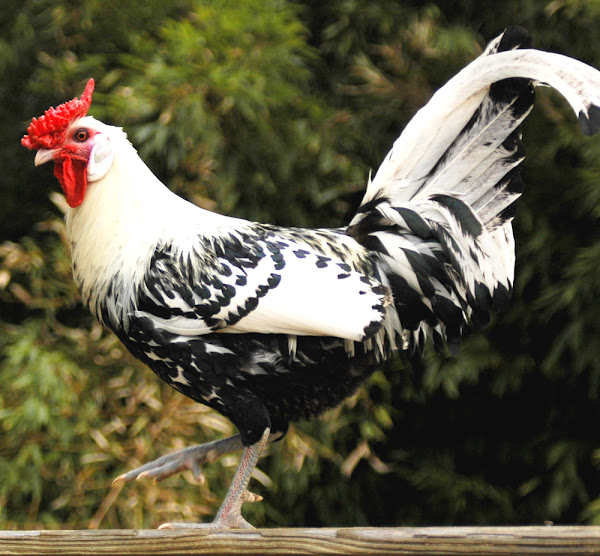Hamburg chicken is one of the most beautiful, snappiest and most alert breed on the poultry list. It is elegant, smaller in size with light but sweeping, graceful outlines.
Hamburg chicken carry a German name, but it’s origin is somewhat unclear. Some experts believe that it is a much older breed that developed somewhere in the Mediterranean area, most likely from Turkey.
While others agree that the breed was originally bred in Holland and Hamburg during the 1840s. Actually, no one is really sure about where the Hamburg chicken originated. But it is most likely to be the United Kingdom, Germany and Netherlands.
The British and Dutch strongly influenced the Hamburg varieties that we see today. Hamburg chicken has strong flying abilities, and was once thought to be the result of a cross between pheasants and common farm chickens.
Hamburg chicken was also once called pheasant or pheasant fowl, mainly because of it’s likeness to pheasants.
The breed has been known to exist since the fourteenth century. It was accepted into the American Poultry Association’s Standard of Perfection in the year of 1874.
There is bantam version available of this chicken breed. The Hamburg chicken is listed in the Watch category of the American Livestock Breeds Conservancy’s Conservation Priority List.
Hamburg Chicken Characteristics
Hamburg chickens are graceful birds with long, compact bodies and wide flat shoulders. They have well rounded breast, long sweeping tail and their large wings are neatly tucked.
Hamburg chicken appears in more than 10 varieties. The different colors or varieties also have different sizes. Among those varieties, the Spangled form is intermediate in size, the Pencilled forms are the smallest, and the Self-colored birds are the largest.
But all the varieties are not recognized by the American Poultry Association. American Poultry Association recognizes only six Hamburg chicken breed varieties. Which are Black, Golden Penciled, Golden Spangled, Silver Penciled, Silver Spangled and White.
All the varieties of Hamburg chicken breed have red colored rose combs and standard plumage. White earlobes which are close to head, red well rounded wattles and red combs are the main characteristics of Hamburg chickens. Their rose combs have small points and the comb gradually tapers into a long fine spike.
Wattles are round and smooth and medium in size in roosters and small in hens. And the earlobes are also smooth, round and flat. Their legs are featherless.
Legs color can vary depending on the different variety. Their legs are grayish-blue in color in most varieties, except the Black variety. In Black variety, the legs are black.

Hamburg chicken has short and curved dark horn beak, and their neck is fully feathered. Their skin color is white. It’s a small or medium sized chicken breed.
Standard Hamburg roosters weight about 2-2.5 kg and hens about 1.6-1.8 kg. And the bantam roosters weight about 0.68-0.79 kg and hens about 0.62-0.74 kg. Photo from Wikipedia.
Behavior/Temperament
Hamburg chickens are excellent small birds used for both beauty and utility. They are great layers of small white eggs, and also known as ‘Everyday Layers’. Especially the bantam version lays more eggs than the larger breed. Hamburg chickens are very cold hardy and do extremely well in cold weather.
They are very active, alert and good flyers. Hamburg chicken is also great forager, take most of it’s food foraging and also an economic breed. And the breed can’t do well in confinement. They need good amount of range for grazing. Free range environment and large coops are best for keeping Hamburg chicken.
Hamburg chicken can also be kept in a run. But the run needs to have adequate space for keeping this lively chicken happy. They can become bored easily and can take their frustrations out on other hens, causing injury.
So free range environment is good for this breed. They love to roost on higher place, such as tall trees. As the breed is flighty in nature, so a large enclosure or a fence is required for keeping them within your property.
The Hamburg chicken is not especially friendly with humans, but they tend to prefer other chicken’s company. Chicks are strong, feather up fast and mature quickly. Pullets begin to lay at about 4-5 months of age.
Hamburg chicken is not good for meat purpose, because they have a grayish skin which is rather unappetising. However, Hamburg chickens are sprightly, chipper little birds that look festive decorating your yard. Review full breed profile of Hamburg chicken below.
| Breed Name | Hamburg |
| Other Names | Dutch: Hollandse Hoen
German: Hamburger UK: Hamburgh |
| Breed Purpose | Eggs, Ornamental |
| Breed Temperament | Wild, Flighty, Restless, Can’t Bear Confinement Well |
| Breed Size | Large |
| Broodiness | Seldom |
| Comb | Rose |
| Climate Tolerance | All Climates/Cold Hardy |
| Egg Color | White |
| Egg Size | Small |
| Egg Productivity | Medium (bantam version lays more eggs than the large breed) |
| Feathered Legs | No |
| Rarity | Common |
| Varieties | Six varieties are recognized by the American Poultry Association, which are; Black, Golden Penciled, Golden Spangled, Silver Penciled, Silver Spangled and White. |
| Country of Origin | Unclear. Probably Holland or United Kingdom |






